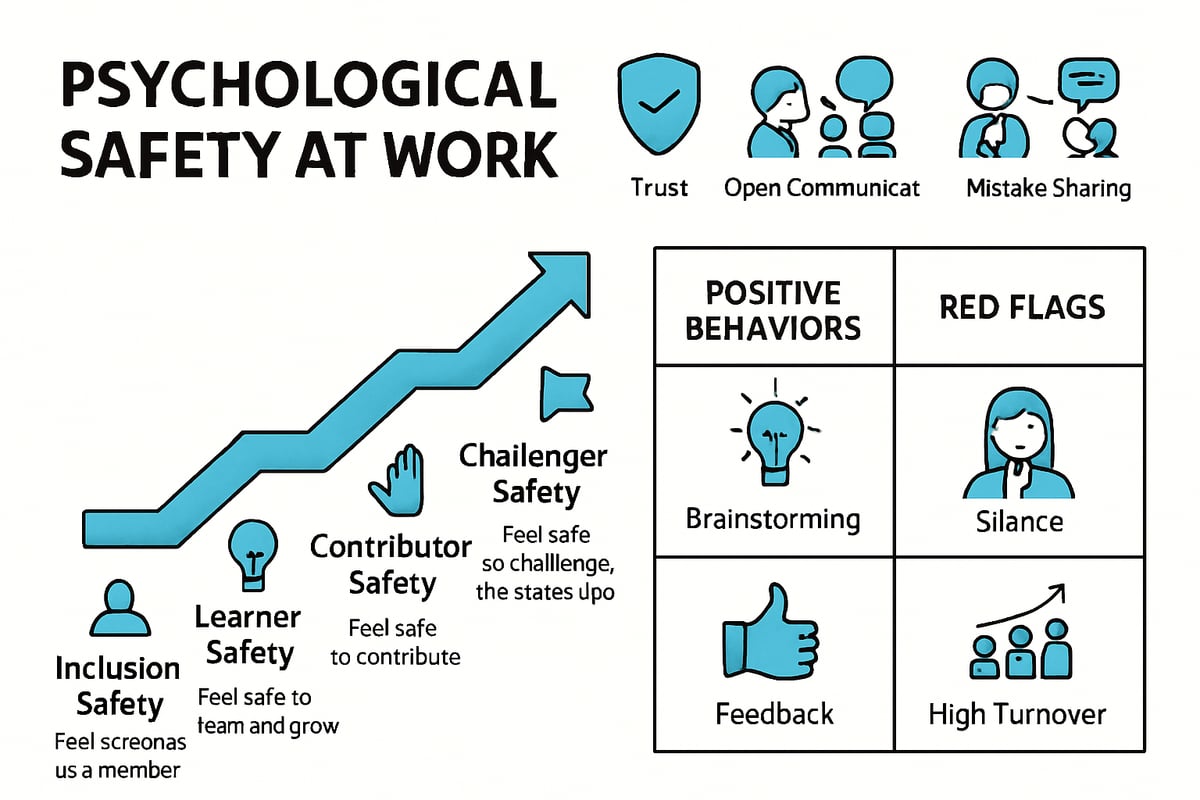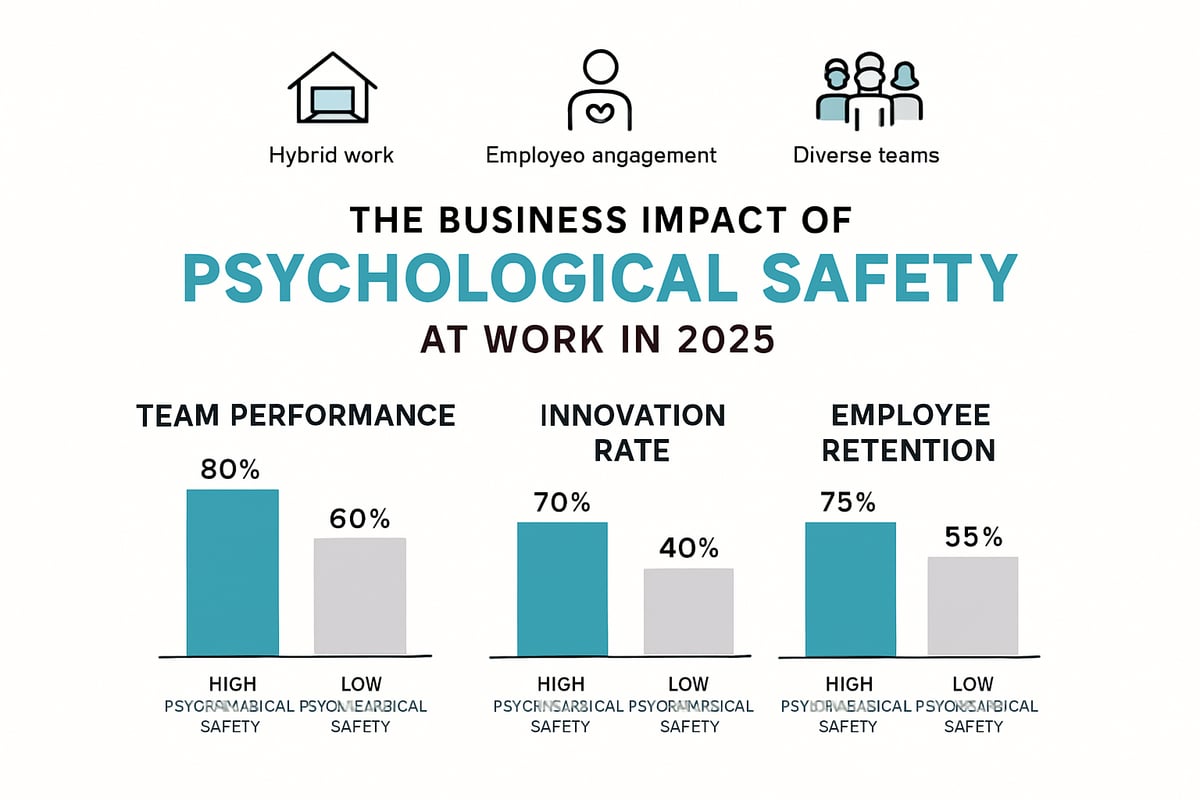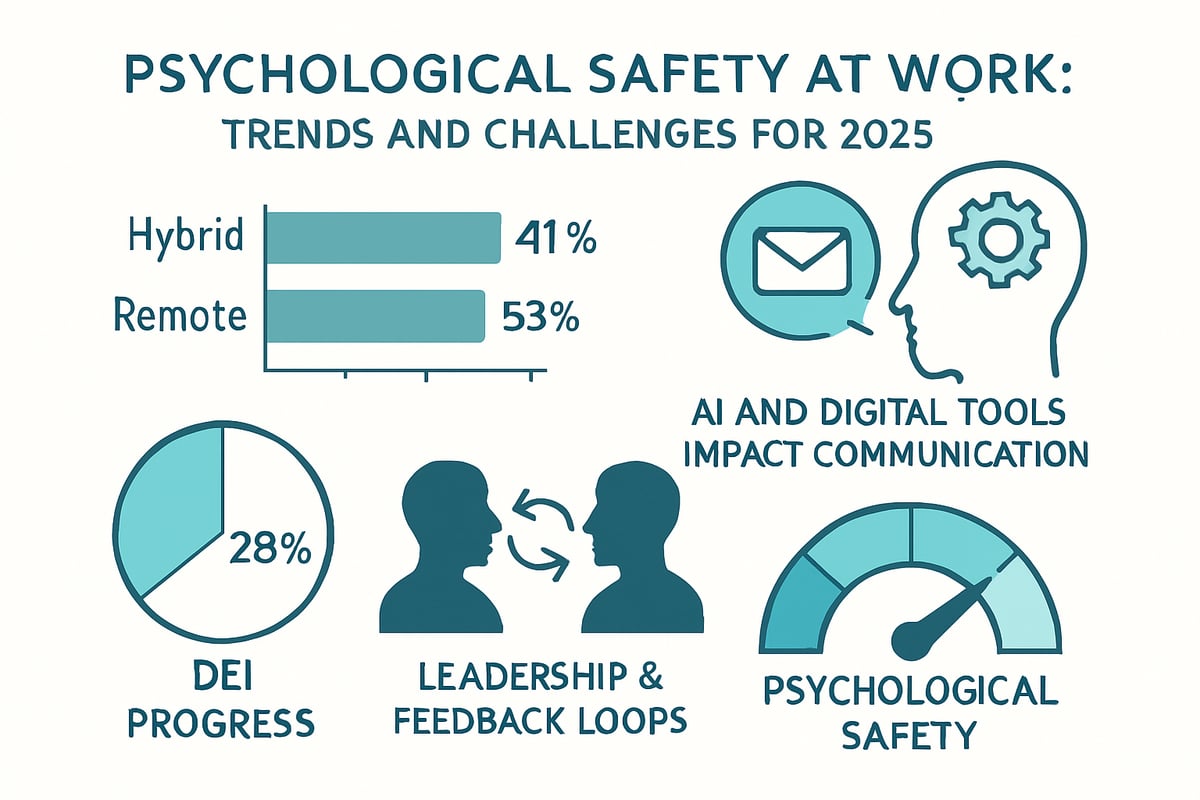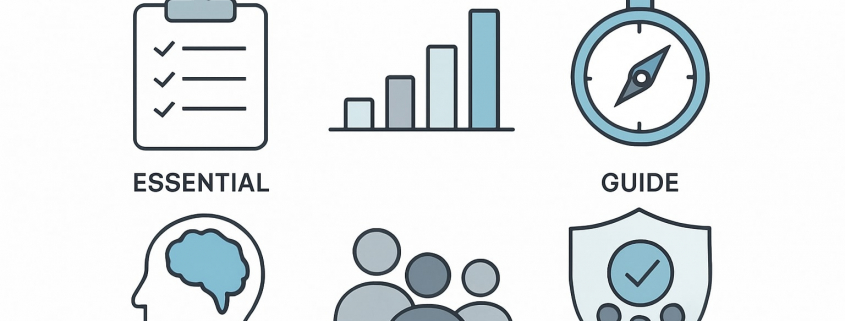Essential Guide to Psychological Safety at Work in 2025
In today’s rapidly evolving workplace, psychological safety at work is no longer optional for organizations aiming to stay competitive. Teams that feel safe to share ideas, admit mistakes, and challenge norms consistently outperform those that do not. This essential guide breaks down why psychological safety at work is mission-critical in 2025. You’ll discover what it means, see the proof of its business impact, learn about emerging trends and challenges, and gain a practical roadmap for leaders and HR professionals ready to take action.
Understanding Psychological Safety at Work
Psychological safety at work is more than a buzzword—it’s the foundation of high-performing teams and resilient organizations. As workplaces grow more complex, understanding what creates a psychologically safe environment is essential for leaders and employees alike.

What is Psychological Safety?
Psychological safety at work is the shared belief that team members can take interpersonal risks without fear of negative consequences. This means employees feel safe to express ideas, ask questions, admit mistakes, and offer feedback. Key attributes include openness, trust, and the freedom to challenge the status quo. Importantly, psychological safety at work is not about being agreeable all the time—it’s about candor, constructive feedback, and healthy debate.
Google’s Project Aristotle famously found that psychological safety at work was the number one predictor of team effectiveness. Supporting this, research from the Center for Creative Leadership reports that teams who experience high psychological safety at work achieve better performance and encounter fewer conflicts. For a deeper dive, see Understanding Psychological Safety.
The Four Stages of Psychological Safety
The journey to psychological safety at work unfolds in four progressive stages: inclusion safety, learner safety, contributor safety, and challenger safety. Inclusion safety is the foundation—everyone feels accepted and valued. Learner safety allows people to ask questions and make mistakes without judgment. Contributor safety empowers individuals to share ideas and participate actively. Finally, challenger safety enables team members to challenge norms and suggest new approaches.
Each person’s experience of psychological safety at work may vary, especially in diverse or senior teams. Leaders must be aware that even within the same group, perceptions of safety can differ significantly.
Psychological Safety vs. Other Workplace Concepts
It’s easy to confuse psychological safety at work with trust, engagement, or diversity and inclusion. However, psychological safety at work specifically refers to the environment where people feel safe to take risks and be vulnerable in front of each other. Unlike general trust, it is about the group dynamic, not just individual relationships.
Psychological safety at work is a key enabler of innovation and collaboration. It doesn’t mean avoiding conflict; rather, it allows for productive disagreement and debate. Misconceptions can lead people to think psychological safety at work is about comfort, when it’s truly about growth and honest communication.
Signs of a Psychologically Safe Work Environment
How do you know if psychological safety at work is present? Look for these behaviors and indicators:
| Positive Signs | Red Flags |
|---|---|
| Brainstorming out loud | Silence in meetings |
| Sharing half-formed ideas | Fear of speaking up |
| Respectful disagreement | Lack of feedback |
| High engagement | High turnover |
| Willingness to challenge | Defensive reactions |
In environments with strong psychological safety at work, team members feel comfortable voicing opinions, even if they differ from the majority. Conversely, a lack of psychological safety at work leads to disengagement and missed opportunities for improvement.
The Cost of Low Psychological Safety
When psychological safety at work is lacking, the consequences ripple through the organization. Teams miss out on innovation, make poorer decisions, and see drops in engagement. Gallup found that only 3 in 10 employees feel their opinions count at work—a stark reminder of the toll on morale and performance.
Without psychological safety at work, failing initiatives drag on because no one feels safe to speak the truth. This results in costly mistakes, higher turnover, and stagnant cultures that resist change.
The Business Impact of Psychological Safety in 2025
In 2025, psychological safety at work is more than a buzzword. It is a strategic imperative for organizations navigating rapid change, remote collaboration, and evolving employee expectations. As the workplace shifts, leaders who prioritize psychological safety at work see stronger teams, greater innovation, and measurable business gains.

Why Psychological Safety Matters Now More Than Ever
The workplace has transformed since 2020, and psychological safety at work is now at the core of resilient organizations. Hybrid and remote teams face new barriers to trust, while complexity in roles and responsibilities demands open dialogue. Without psychological safety at work, innovation stalls and team members hesitate to share ideas. For example, a Catalyst survey found nearly half of female leaders still struggle to speak up in virtual meetings. This highlights the urgent need for safe spaces where everyone’s voice is valued.
Connection to Organizational Performance
Research consistently shows that psychological safety at work fuels innovation, problem-solving, and adaptability. Teams with high psychological safety at work outperform others on key performance indicators and are better equipped to manage risk. According to a CCL study, these teams experience less interpersonal conflict and achieve more consistent outcomes. Access to real-time feedback and honest communication leads to better decisions and faster pivots, which is essential in today’s fast-paced market. For more on recent data, see Psychological Safety Statistics: Reports 2025.
Psychological Safety and Employee Engagement
Engagement is a clear indicator of psychological safety at work. When employees feel safe, they are more likely to contribute ideas, challenge outdated processes, and remain committed to team goals. Conversely, a lack of psychological safety at work often results in disengagement, reduced productivity, and higher turnover. Gallup data reveals that only 3 in 10 employees feel their opinions count, underscoring the critical gap organizations must address. High engagement, fostered by psychological safety at work, translates directly into improved business outcomes.
Inclusion, Equity, and Psychological Safety
For marginalized and underrepresented groups, psychological safety at work is vital yet often lacking. Inclusive leadership is essential to close this gap and ensure all voices are heard. Studies show that underrepresented employees report higher rates of being overlooked or dismissed. Addressing social identity dynamics and building equity into team norms allows psychological safety at work to flourish for everyone. This not only supports fairness but also unlocks diverse perspectives that power organizational growth.
The Bottom-Line Benefits
The financial and cultural benefits of psychological safety at work are substantial. Organizations that invest in psychological safety at work see reduced turnover, increased innovation, and stronger collaboration. Early identification of problems prevents costly failures, while teams are empowered to solve challenges creatively. Companies with coaching cultures report more honest conversations and better results. Ultimately, psychological safety at work drives retention, accelerates growth, and positions organizations to win in the evolving world of work.
Key Trends and Challenges in Psychological Safety for 2025
Building and sustaining psychological safety at work is more complex than ever. Rapid shifts in how we collaborate, communicate, and lead are reshaping the landscape. Leaders and HR professionals must understand the evolving trends that impact psychological safety at work, so they can proactively address challenges and seize new opportunities.

The Hybrid and Remote Work Paradigm
The rise of hybrid and remote work is transforming psychological safety at work. Distributed teams face unique challenges, including reduced face-to-face interaction and fewer informal conversations. This can make it harder to build trust and rapport.
However, remote settings also create new opportunities for openness. Employees often feel more comfortable sharing concerns through digital channels than in person. For example, some teams report higher participation rates in virtual brainstorming sessions, as chat features allow quieter voices to be heard.
To foster psychological safety at work in a hybrid world, leaders must intentionally create inclusive spaces for feedback and dialogue. Regular virtual check-ins and team rituals can help bridge the distance and keep everyone connected.
Technology, AI, and Workplace Communication
Technology and AI are reshaping how feedback, recognition, and collaboration occur, directly influencing psychological safety at work. Digital platforms make it easier to share ideas and surface concerns, but they also introduce risks.
Misinterpretation of tone in written messages, lack of nuance, and potential digital exclusion can undermine safety. For example, employees may hesitate to speak up if they feel their input will be misunderstood or ignored in a busy chat thread.
To maintain psychological safety at work, organizations must train teams on digital etiquette and ensure that communication tools are accessible to all. Leveraging AI-driven feedback systems can help leaders spot patterns and intervene early, supporting a culture of openness and support.
Diversity, Equity, and Belonging Initiatives
In 2025, integrating psychological safety at work into DEI strategies is essential. Marginalized employees often face greater barriers to feeling safe, such as microaggressions or exclusion from key conversations.
Companies are now embedding psychological safety at work into their DEI frameworks, addressing systemic bias and fostering inclusive norms. For instance, some organizations use anonymous feedback tools and regular training to elevate underrepresented voices.
Prioritizing psychological safety at work ensures everyone, regardless of background, has a fair chance to contribute, innovate, and shape the organization’s future. Inclusive policies and visible leadership commitment are key to lasting progress.
Leadership Development and Accountability
The demand for leaders who can champion psychological safety at work is surging. Effective leaders model vulnerability, create feedback loops, and address toxic behaviors swiftly.
Executive coaching, ongoing assessments, and structured feedback are becoming standard. Companies like Accountability Now are helping organizations embed accountability and safety into their leadership culture, driving real behavioral change.
Building psychological safety at work is not a one-time effort. Leaders must continually develop their skills, seek honest input, and hold themselves accountable for creating a safe environment where all voices matter.
Measuring and Sustaining Psychological Safety
Measuring psychological safety at work is both crucial and challenging. Tools like surveys, 360-degree assessments, and pulse checks provide valuable insights, but perceptions can vary widely, especially at the senior leadership level.
According to The State of Psychological Safety Survey: 2025, 62 percent of senior teams report significant differences in how safe they feel, highlighting the importance of continuous measurement and adaptation. Organizations like Accountability Now recommend transparent sharing of survey results and clear action planning.
By consistently tracking psychological safety at work and adjusting strategies based on feedback, companies can create environments where innovation and engagement thrive, even as the workplace continues to evolve.
8 Essential Steps to Building Psychological Safety at Work
Building psychological safety at work is not a one-time initiative. It requires a deliberate, ongoing commitment from leaders and teams at every level. Here are eight essential steps, each rooted in research and best practices, to help you create an environment where everyone feels safe to contribute, learn, and thrive.
Step 1: Make Psychological Safety an Explicit Priority
Start by making psychological safety at work a core value. Leadership should communicate its importance regularly, linking it directly to organizational purpose and success. Set clear expectations that psychological safety at work is non-negotiable for all teams.
Integrate discussions about psychological safety at work into meetings, company updates, and training sessions. When leaders prioritize this openly, employees recognize that their voices matter.
Step 2: Facilitate Everyone Speaking Up
Encourage open dialogue by ensuring every team member has the opportunity to speak. Use round-robin discussions or anonymous input tools to make sure all perspectives are heard, especially from quieter voices.
Active listening is vital for psychological safety at work. Ask clarifying questions and show appreciation for contributions, even when ideas challenge the norm. This approach builds confidence and strengthens team trust.
Step 3: Establish Norms for Handling Failure
Treat mistakes as learning opportunities, not as reasons for blame. Develop clear protocols for debriefing after setbacks, so teams can reflect and grow together.
Organizations committed to psychological safety at work create a “fail fast, learn fast” culture. Leaders should model constructive responses to errors and encourage teams to share lessons learned. This helps prevent repeated missteps and fosters innovation.
Step 4: Model Vulnerability and Authenticity
Leaders can powerfully influence psychological safety at work by admitting their own mistakes and sharing what they learned. Authenticity from the top normalizes asking for help and giving or receiving feedback.
When executives openly discuss their growth journeys, it signals to employees that vulnerability is valued. This transparency encourages others to follow suit, building a culture where trust and candor are the norm.
Step 5: Build Inclusive Team Practices
Adopt inclusive habits that support psychological safety at work, such as rotating facilitators and using anonymous feedback tools. Address microaggressions or moments of exclusion swiftly to show zero tolerance for harmful behavior.
Inclusive practices ensure all voices are valued. Implement “no interruption” rules during discussions and encourage team members to challenge the status quo respectfully. For more strategies on leveling the playing field, see Psychological Safety Levels the Playing Field for Employees.
Step 6: Provide Regular, Constructive Feedback
Frequent, actionable feedback is a cornerstone of psychological safety at work. Train managers to deliver feedback that is specific, supportive, and focused on growth.
Encourage peer-to-peer recognition and establish 360-degree feedback systems. When feedback is normalized and expected, employees feel empowered to take risks and share ideas without fear.
Step 7: Invest in Leadership Development and Coaching
Sustaining psychological safety at work requires leaders who understand its value and know how to foster it. Invest in ongoing leadership development, including topics like empathy, inclusion, and trust-building.
Leverage external coaching programs and mentorship to accelerate leader growth. Organizations with coaching cultures report stronger psychological safety at work and higher engagement. Explore Leadership Coaching Opportunities to learn how coaching can transform your workplace. For proven accountability frameworks, visit Accountability Now.
Step 8: Monitor, Measure, and Adapt
Consistently measure psychological safety at work using surveys, data analytics, and pulse checks. Share results with teams and adjust strategies based on real feedback.
Tracking progress helps leaders identify gaps and celebrate improvements. Make psychological safety at work a metric for success, reviewed and discussed during regular performance reviews and company updates.
How Leadership Coaching Programs Support Psychological Safety
Leadership coaching programs, such as those offered by Noomii, are instrumental in advancing psychological safety at work. These programs equip leaders with skills to build trust, encourage open dialogue, and address toxic behaviors that undermine safety.

Noomii’s evidence-based assessments help organizations pinpoint gaps in psychological safety at work and implement targeted interventions. Precision coach matching ensures leaders receive the support they need, whether managing diverse teams or improving communication.
By integrating leadership coaching into broader development strategies, companies can achieve measurable outcomes and lasting cultural change. This commitment to psychological safety at work results in stronger teams and a healthier, more innovative workplace.
Actionable Strategies for Leaders and HR Professionals
Creating sustainable psychological safety at work requires intentional actions from leaders and HR professionals. These strategies translate research into daily practice, helping your organization unlock high performance and resilience. By embedding psychological safety at work into the culture, communication, and measurement frameworks, you can drive real change and measurable results.
Embedding Psychological Safety into Organizational Culture
To make psychological safety at work a core value, align organizational mission, policies, and leadership expectations with safety principles. Leaders should model vulnerability, encourage feedback, and set clear standards for respectful behavior.
- Integrate psychological safety metrics into performance reviews
- Recognize and reward safe behaviors publicly
- Regularly discuss safety in team meetings and town halls
Team coaching is highly effective for embedding these values. For example, Team Coaching for Safe Workplaces demonstrates how dedicated coaching can accelerate adoption of psychological safety practices and foster team trust. HR plays a crucial role in championing these efforts across all levels.
Inclusive Communication and Decision-Making
Transparent communication is essential for psychological safety at work. Leaders should keep information accessible and invite input from all employees. Inclusive decision-making ensures everyone feels their voice matters.
- Hold open forums and “ask me anything” sessions with executives
- Use clear, jargon-free language in all communications
- Encourage questions and challenge assumptions in meetings
By fostering open dialogue, organizations empower employees to share concerns or ideas without fear, driving innovation and continuous improvement.
Supporting Marginalized and Underrepresented Employees
Supporting psychological safety at work means actively removing barriers for marginalized groups. Underrepresented employees often face greater risks when speaking up, so it’s vital to create tailored support systems.
- Establish mentorship and sponsorship programs
- Create dedicated feedback channels for marginalized voices
- Launch affinity networks to foster belonging
According to Why 1 in 4 Employees Still Don’t Feel Safe Speaking Up at Work, persistent gaps in safety disproportionately affect minorities. Addressing these issues head-on boosts engagement and helps all employees thrive.
Leveraging Technology for Psychological Safety
Digital tools can enhance psychological safety at work when used thoughtfully. Platforms for anonymous feedback, recognition, and collaboration encourage honest input and surface concerns early.
- Use pulse surveys to gauge team sentiment in real time
- Implement chat tools for instant, low-stakes feedback
- Train teams on digital etiquette and inclusive engagement
Technology bridges gaps in hybrid workplaces, making it easier for everyone to participate and be heard, regardless of location or schedule.
Measuring Success and Driving Continuous Improvement
Measuring psychological safety at work is essential for tracking progress and identifying areas for growth. Use data to inform action plans and maintain accountability.
- Set clear benchmarks and KPIs for psychological safety
- Analyze survey results and share findings with teams
- Review progress quarterly and adjust strategies as needed
Continuous measurement ensures psychological safety remains a living, evolving part of your organization’s culture, not a one-time initiative.




Leave a Reply
Want to join the discussion?Feel free to contribute!